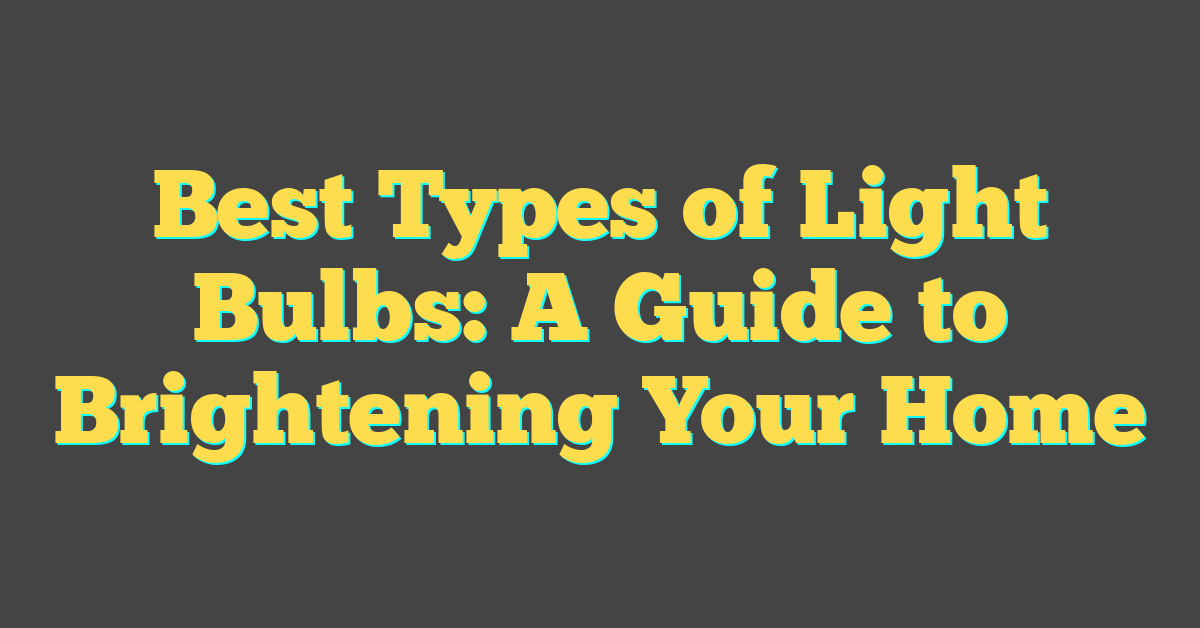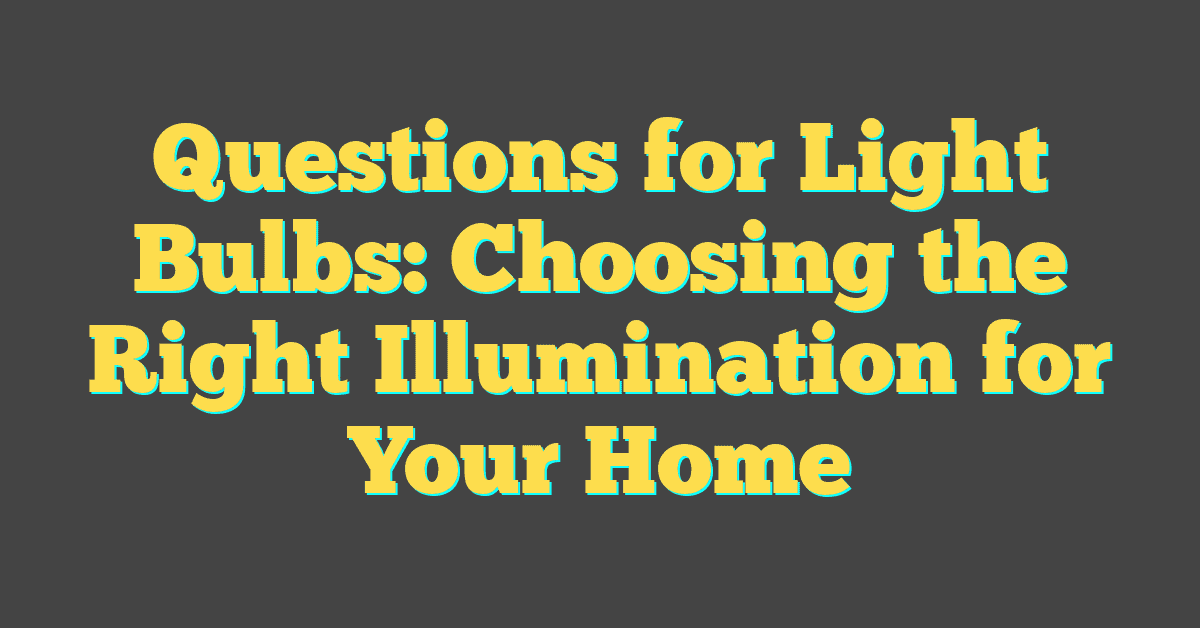Ever wondered if your outdoor lighting setup needs a special kind of bulb? You’re not alone. Choosing the right light bulb for outdoor use is crucial, not just for the longevity of your lights but also for safety and efficiency.

Outdoor lighting faces the elements, from scorching sun to freezing snow, and everything in between. That’s why it’s important to know what to look for when you’re picking out bulbs for your garden, porch, or driveway. Let’s shed some light on the subject and ensure your outdoor spaces are both well-lit and weather-ready.
What are outdoor light bulbs?
Outdoor light bulbs are specifically designed to handle the challenges of exterior environments. Unlike their indoor counterparts, these bulbs are built to endure factors like extreme temperatures, moisture, and varying weather conditions. When you’re choosing bulbs for your outdoor spaces, you’re not just looking for illumination; you’re looking for resilience and durability.
Here’s what sets outdoor light bulbs apart:
- Weather Resistance: Outdoor bulbs are made with materials that won’t crack or break easily under harsh weather. Think about it – you wouldn’t want to be changing bulbs in the middle of a snowstorm, would you?
- Temperature Tolerance: Whether it’s the heat of the summer or the chill of the winter, outdoor bulbs are crafted to function optimally across a range of temperatures.
- Longevity: These bulbs often have a longer lifespan, because constantly replacing outdoor bulbs can be a hassle. Plus, nobody enjoys climbing ladders more than they have to.
Key Features to Look For
When shopping for outdoor light bulbs, you’ll want to keep your eyes peeled for a few key features:
- Brightness Level: Lumens are the measure of brightness, and for outdoor bulbs, you’ll need a higher lumen count to effectively illuminate large areas.
- Energy Efficiency: LED bulbs are a prime choice for outdoor lighting, offering both energy efficiency and a longer lifespan.
- Bulb Shape and Size: Make sure the shape and size fit your specific fixtures. The last thing you need is a bulb that’s too big or too awkwardly shaped to fit.
Remember, while the bulb’s performance is crucial, the right type of fixture can further enhance your bulb’s efficacy and longevity. So, don’t just focus on the bulb – give your fixtures a thought as well. Whether it’s for your garden, porch, or driveway, the right partnership between bulb and fixture ensures that your outdoor lighting remains bright and reliable, shining through the darkest nights and the stormiest weather.
Factors to consider when choosing outdoor light bulbs

If you’re a home DIY enthusiast or a lighting aficionado, knowing what to look for in outdoor light bulbs is essential. Outdoor lighting isn’t just about illuminating your space; it’s about creating ambiance and ensuring safety. Here’s what you need to keep in mind:
Weather Resistance
Outdoor bulbs encounter rain, snow, and heavy winds. Look for bulbs with a high Ingress Protection (IP) rating, indicating their level of protection against the elements. An IP65 rating or higher means your bulb can handle more than just a sprinkle.
Temperature Tolerance
Temperature fluctuations are inevitable. Whether you’re dealing with the scorching sun or frosty nights, your bulbs need to be up to the task. Make sure the specs mention suitable temperature ranges. LEDs often have better tolerance compared to incandescent bulbs.
Longevity
Replacing outdoor bulbs too frequently is a hassle you don’t need. LEDs last longer than traditional bulbs – often up to 25,000 hours or more. This durability translates into savings and convenience in the long run.
Brightness Level and Energy Efficiency
It’s important to strike a balance between brightness and efficiency. You want your outdoor area well-lit without the lights being overpowering or excessively costly. LED bulbs often offer the best lumens-to-watt ratio, providing bright light while keeping energy consumption low.
Bulb Shape and Size
The fixture you’re outfitting will dictate the shape and size of the bulb you need. Floodlights, spotlights, and decorative bulbs each serve different purposes and fit specific types of fixtures.
Fixture Compatibility
Lastly, don’t overlook the importance of finding a bulb that complements your fixture. Certain fixtures may require bulbs of a specific wattage or design to function optimally without overheating. Always check the manufacturer’s recommendations to ensure compatibility.
Armed with this knowledge, you’ll be well-equipped to choose the best outdoor lighting solutions. Remember, the right bulb not only adds to the aesthetics of your home but also contributes to its safety and functionality. Keep exploring your options and trust your DIY skills to light up your outdoor space brilliantly.
The importance of durability and weather resistance
« Appliance Light Bulb vs Regular: The Home Lighting Choice That Matters
What Light Bulbs Give Off Yellow Light? Discover Cozy Glow Options »

When decking out your outdoor space with lighting, it’s crucial to consider the relentless nature of the elements. Outdoor light bulbs face a gauntlet of environmental stressors, from torrential downpours to scorching sunbeams. Durability and weather resistance are not just nice-to-haves; they’re absolute musts.
Tackling Temperature Fluctuations
One of the first things you’ll notice about outdoor bulbs is how they hold up under extreme temperatures. During summer, your bulbs can get as hot as the midday sun, while in winter, they might endure freezing cold. This is where choosing bulbs designed to withstand these fluctuations comes into play. LED bulbs, in particular, are champion performers in both sweltering heat and icy conditions. They maintain their function without losing brightness or efficiency.
Standing Strong Against Storms
Outdoor bulbs also need to be capable of standing strong against high winds, rain, and even snow. Look for bulbs with a tight seal and robust construction. These bulbs should have ratings like IP65 or higher, indicating solid protection against dust and water jets. This is your assurance that when you hear the howl of a storm, your outdoor lighting won’t flicker or fail.
Lasting Through the Seasons
You don’t want to be replacing your bulbs with every change in the weather. Longevity is key here. LED bulbs don’t just save you energy; they last way longer than their incandescent counterparts. With typical lifespans ranging into tens of thousands of hours, you’ll enjoy your well-lit evenings for years without frequent bulb changes. It’s the peace of mind that, once you’ve installed them, you can trust they’ll brighten your space night after night, through spring showers and autumn leaves alike.
Resilience is Key
Remember, the sturdier the bulb, the fewer your worries about maintenance and replacements. Investing in high-quality, durable, and weather-resistant light bulbs means more time enjoying your outdoor oasis and less time climbing ladders to deal with the fallout of a busted bulb. Opt for products that promise endurance and you’ll find your outdoor lighting project is not just a seasonal affair, but a lasting investment in your home’s ambiance.
Different types of outdoor light bulbs

When dressing up your outdoor space, knowing the different types of bulbs can make all the difference. You don’t want just any bulb—you want the right one for the job. Here’s a spotlight on the most popular choices:
Incandescent Bulbs
The traditional choice, these guys have been lighting up yards for ages. They’re inexpensive and cast a warm, inviting glow that’s so important for cozy evenings outside. But beware, they’re not the champions of energy efficiency or longevity. You might find yourself changing these more often than you’d like.
Compact Fluorescent Bulbs (CFLs)
A step up in the efficiency game, CFLs use far less power than their incandescent cousins. They come in a range of color temperatures, so you can customize to your heart’s content. Remember though, they need a bit of time to warm up and reach full brightness.
Light Emitting Diode (LED)
LED bulbs are the talk of the town and with good reason. Not only do they sip electricity, making them incredibly efficient, but they also boast impressive lifespans. No need to climb the ladder to replace these regularly. Plus, they come ready to brave the temps, which is a plus for any outdoor setting.
Halogen Bulbs
Bright and intense, halogen bulbs are known for their crisp light that makes colors pop. Perfect for highlighting your garden’s best features. They are more efficient than incandescents but still heat up quite a bit, so they’re not the top pick for energy-conscious folks.
Specialized Outdoor Bulbs
Sometimes, your outdoor space demands something more specific. Think motion-sensing bulbs for security, or bulbs that deter bugs. There’s a whole niche of specialty bulbs designed for the great outdoors, each with its unique feature set catering to specific needs.
Solar-Powered Lights
Embrace the sun’s power with solar-powered lights. They charge up during the day and light up your space at night without pulling from the grid. They’re a sustainable choice and an absolute gem for off-the-beaten-path areas where wiring can be a challenge.
So there you have it—no shortage of options for your outdoor lighting needs. Keep compatibility, energy consumption, and the unique demands of your outdoor environment in mind, and you’ll light the way to the perfect ambiance.
Energy efficiency considerations for outdoor light bulbs

When you’re illuminating the exterior of your home, energy efficiency isn’t just a buzzword; it’s a cornerstone of cost-effective and environmentally friendly lighting design. A well-chosen bulb not only lights up your outdoor space but also ensures you’re not spending a fortune on your energy bills.
LED bulbs stand out as the champion of energy efficiency. They use significantly less power than traditional incandescent bulbs and have a much longer lifespan. Imagine not having to climb up that ladder to change bulbs so often—LEDs can last years, even with the extended use outdoor lighting often demands.
Let’s talk numbers. On average, an LED bulb uses about 75-80% less energy than an incandescent bulb. These savings can be dramatic over time, especially if your outdoor lighting is a prominent feature of your home.
| Type of Bulb | Average Wattage | Expected Lifespan (Hours) |
|---|---|---|
| LED | 6-8 | 15,000 – 50,000 |
| Incandescent | 60 | 1,000 – 2,000 |
| CFL | 15-18 | 8,000 – 15,000 |
| Halogen | 45-50 | 2,000 – 4,000 |
If you’re leaning towards solar-powered lights for their zero energy cost, remember their efficiency varies based on daily sun exposure. They’re fantastic for areas with plenty of sunlight but less ideal in settings prone to shade or overcast conditions.
When assessing energy consumption, also consider the lumens-to-watt ratio—a measure of how much light you get for each watt of power used. Higher ratios mean more light output for each dollar spent on energy, which is a clear win for your wallet and the planet.
While you’re planning your DIY lighting project or installing new fixtures, think about how you can maximize these ratio benefits. Sometimes, the most impactful lighting isn’t about the brightest bulb, but the one that combines efficiency with just the right light quality for that cozy, inviting outdoor atmosphere you’re aiming for.
Tips for maintaining and replacing outdoor light bulbs
When it comes to maintaining your outdoor light bulbs, a little bit of care goes a long way. It’s not just about replacing a bulb when it burns out—preventive maintenance can extend the life of your bulbs and ensure they operate at peak performance. Here’s what you should keep in mind:
- Regular Cleaning: Dust and debris can accumulate on bulb surfaces and fixtures, potentially diminishing the light output. Gently wipe down bulbs and fixtures with a soft cloth to maintain brightness. Just make sure the electricity is turned off before you start!
- Moisture Check: Outdoor bulbs are exposed to moisture, which can lead to corrosion. Inspect seals on fixtures to protect bulbs from water damage, especially after heavy rain or snow.
Choosing the Right Time to Replace:
Don’t wait for your outdoor bulbs to fail completely before you replace them. Dimming or flickering lights can be a signal that it’s time for a change. Have some bulbs on hand and swap out old ones before they become a nuisance.
Proper Disposal:
Be mindful of how you dispose of different types of bulbs. For instance, CFLs contain a small amount of mercury and should be taken to a recycling center that handles hazardous materials. LED bulbs also have specific disposal recommendations to prevent environmental harm.
Upgrade Your Lighting:
Replacing bulbs offers the perfect opportunity to upgrade. If you’re still using older incandescent bulbs, switching to LED options can bring better efficiency and a longer lifespan. While they might have a higher upfront cost, the investment pays off with reduced energy bills and less frequent replacements.
Remember, the right maintenance and timely replacement of your outdoor light bulbs not only keep your home looking great but can also contribute to safety and energy efficiency. With a bit of attention, you can enjoy reliable and effective outdoor lighting that complements your DIY home projects.
Conclusion
So you’ve got the lowdown on picking the perfect outdoor light bulbs. Remember that taking care of them is just as crucial as the initial choice. Keep ’em clean, stay vigilant for any signs of moisture damage, and don’t wait too long to switch them out. And hey, if you’re thinking about an upgrade, those LED bulbs are a bright idea for saving energy and keeping the lights on longer. Stay safe and shine on!
Frequently Asked Questions
What factors should I consider when choosing outdoor light bulbs?
Durability, weather resistance, and energy efficiency should be top considerations when choosing outdoor light bulbs. LED bulbs are a great option due to their robustness against temperature changes and long-lasting nature.
Are LED bulbs a good choice for outdoor lighting?
Yes, LED bulbs are an excellent choice for outdoor lighting. They offer great temperature tolerance, energy efficiency, and longevity, making them well-suited for outdoor conditions.
How often should I maintain my outdoor light bulbs?
Regular maintenance, such as cleaning and checking for moisture damage, is recommended to ensure the optimal performance of your outdoor light bulbs.
When is the best time to replace outdoor light bulbs?
The best time to replace outdoor light bulbs is before they fail completely. Look for signs of wear, decreased performance, or significant energy consumption as indicators that it’s time for a replacement.
Is it important to properly dispose of old outdoor light bulbs?
Yes, proper disposal of old outdoor light bulbs is important, especially for bulbs like CFLs that contain hazardous materials. Follow local guidelines for recycling or disposing of light bulbs.
Can upgrading to LED bulbs improve energy efficiency?
Upgrading to LED bulbs can significantly improve energy efficiency and reduce energy costs. LED bulbs consume less power and have a longer lifespan compared to traditional bulbs.




